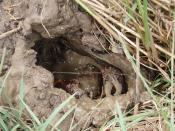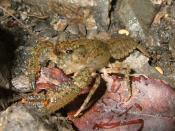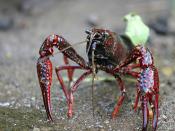Classification
The crayfish falls within the kingdom - anamalia, phylum - Arthropoda, Class - Crustacea, Order -Decapoda , and family - Cambaridae.
Habitat
Crayfish like to be where it's dark and cool, and during much of the daylight they will be found by them selves, under a rock or vegetation, waiting for dark, when they come out to forage for food. This is highly variable, ranging from deep holes to sluggish streams. A suitable habitat is medium-sized streams containing riffles and rocky pools. They burrow very aggressively, burrowing to find warmth, moisture, and food or just to pass the time. In Arizona we are trying to rid of crayfish because they aren't native here and are taking over fish population.
Prey & Predator
Crayfish are omnivorous, which is to eat just about anything they can find or catch either dead or alive. Large food is held and torn to pieces in the large pincers and conveyed to the mouth by the smaller specialized legs near the head.
That's what crayfish do most of the time, loaf all day and look for food all night. Crayfish are an important link in the food chain of the aquatic community. They feed on living animals and plants, and also consume a fair amount of dead plants, dead or dying animals, and detritus. There is also a large number of species of other animals known to eat crayfish. Crayfish have been reported to be preyed upon by at least 46 species of fish, 10 amphibians, 20 reptiles, 38 birds, and 6 mammals (including humans). Crayfish are preyed upon heavily by fish, such as trout, pickerel, and bass, and other invertebrates may eat them.
Body Plan
Crayfish have bodies similar to that of the presumed ancestral crustacean. Such a body is essentially shrimp-like...



Thanks
i needed to know about crayfish
0 out of 2 people found this comment useful.